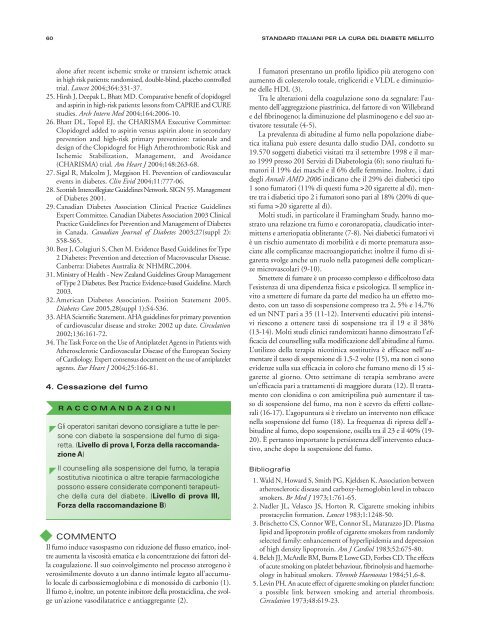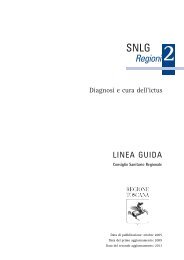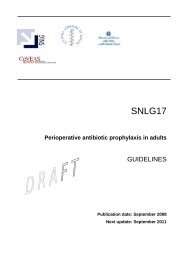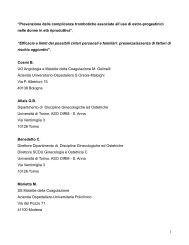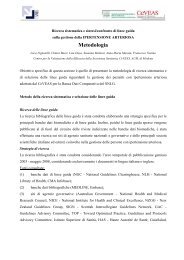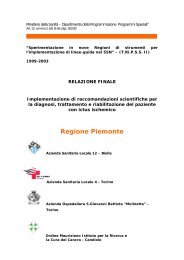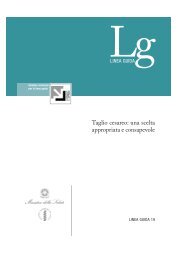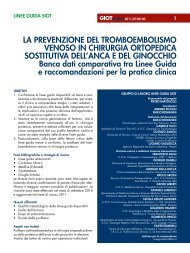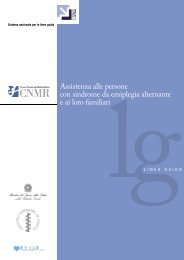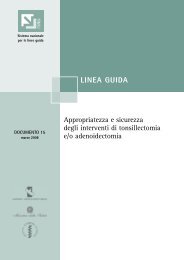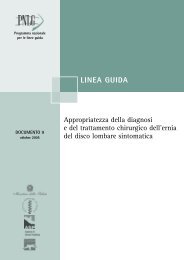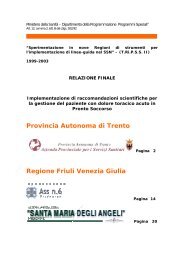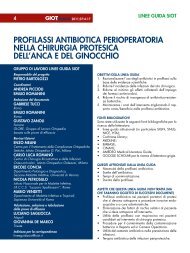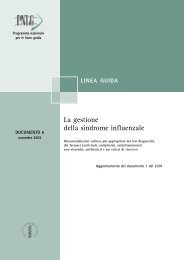Standard italiani per la cura del diabete mellito - AMD
Standard italiani per la cura del diabete mellito - AMD
Standard italiani per la cura del diabete mellito - AMD
You also want an ePaper? Increase the reach of your titles
YUMPU automatically turns print PDFs into web optimized ePapers that Google loves.
60 STANDARD ITALIANI PER LA CURA DEL DIABETE MELLITO<br />
alone after recent ischemic stroke or transient ischemic attack<br />
in high risk patients: randomised, double-blind, p<strong>la</strong>cebo controlled<br />
trial. Lancet 2004;364:331-37.<br />
25. Hirsh J, Deepak L, Bhatt MD. Comparative benefit of clopidogrel<br />
and aspirin in high-risk patients: lessons from CAPRIE and CURE<br />
studies. Arch Intern Med 2004;164:2006-10.<br />
26. Bhatt DL, Topol EJ, the CHARISMA Executive Committee:<br />
Clopidogrel added to aspirin versus aspirin alone in secondary<br />
prevention and high-risk primary prevention: rationale and<br />
design of the Clopidogrel for High Atherothrombotic Risk and<br />
Ischemic Stabilization, Management, and Avoidance<br />
(CHARISMA) trial. Am Heart J 2004;148:263-68.<br />
27. Sigal R, Malcolm J, Meggison H. Prevention of cardiovascu<strong>la</strong>r<br />
events in <strong>diabete</strong>s. Clin Evid 2004;11:777-06.<br />
28. Scottish Intercollegiate Gui<strong>del</strong>ines Network. SIGN 55. Management<br />
of Diabetes 2001.<br />
29. Canadian Diabetes Association Clinical Practice Gui<strong>del</strong>ines<br />
Ex<strong>per</strong>t Committee. Canadian Diabetes Association 2003 Clinical<br />
Practice Gui<strong>del</strong>ines for Prevention and Management of Diabetes<br />
in Canada. Canadian Journal of Diabetes 2003;27(suppl 2):<br />
S58-S65.<br />
30. Best J, Co<strong>la</strong>giuri S, Chen M. Evidence Based Gui<strong>del</strong>ines for Type<br />
2 Diabetes: Prevention and detection of Macrovascu<strong>la</strong>r Disease.<br />
Canberra: Diabetes Australia & NHMRC,2004.<br />
31. Ministry of Health - New Zea<strong>la</strong>nd Gui<strong>del</strong>ines Group Management<br />
of Type 2 Diabetes. Best Practice Evidence-based Gui<strong>del</strong>ine. March<br />
2003.<br />
32. American Diabetes Association. Position Statement 2005.<br />
Diabetes Care 2005,28(suppl 1):S4-S36.<br />
33. AHA Scientific Statement. AHA gui<strong>del</strong>ines for primary prevention<br />
of cardiovascu<strong>la</strong>r disease and stroke: 2002 up date. Circu<strong>la</strong>tion<br />
2002;136:161-72.<br />
34. The Task Force on the Use of Antip<strong>la</strong>telet Agents in Patients with<br />
Atherosclerotic Cardiovascu<strong>la</strong>r Disease of the European Society<br />
of Cardiology. Ex<strong>per</strong>t consensus document on the use of antip<strong>la</strong>telet<br />
agents. Eur Heart J 2004;25:166-81.<br />
4. Cessazione <strong>del</strong> fumo<br />
RACCOMANDAZIONI<br />
Gli o<strong>per</strong>atori sanitari devono consigliare a tutte le <strong>per</strong>sone<br />
con <strong>diabete</strong> <strong>la</strong> sospensione <strong>del</strong> fumo di sigaretta.<br />
(Livello di prova I, Forza <strong>del</strong><strong>la</strong> raccomandazione<br />
A)<br />
Il counselling al<strong>la</strong> sospensione <strong>del</strong> fumo, <strong>la</strong> terapia<br />
sostitutiva nicotinica o altre terapie farmacologiche<br />
possono essere considerate componenti terapeutiche<br />
<strong>del</strong><strong>la</strong> <strong>cura</strong> <strong>del</strong> <strong>diabete</strong>. (Livello di prova III,<br />
Forza <strong>del</strong><strong>la</strong> raccomandazione B)<br />
◆ COMMENTO<br />
Il fumo induce vasospasmo con riduzione <strong>del</strong> flusso ematico, inoltre<br />
aumenta <strong>la</strong> viscosità ematica e <strong>la</strong> concentrazione dei fattori <strong>del</strong><strong>la</strong><br />
coagu<strong>la</strong>zione. Il suo coinvolgimento nel processo aterogeno è<br />
verosimilmente dovuto a un danno intimale legato all’accumulo<br />
locale di carbossiemoglobina e di monossido di carbonio (1).<br />
Il fumo è, inoltre, un potente inibitore <strong>del</strong><strong>la</strong> prostaciclina, che svolge<br />
un’azione vasodi<strong>la</strong>tatrice e antiaggregante (2).<br />
I fumatori presentano un profilo lipidico più aterogeno con<br />
aumento di colesterolo totale, trigliceridi e VLDL e diminuzione<br />
<strong>del</strong>le HDL (3).<br />
Tra le alterazioni <strong>del</strong><strong>la</strong> coagu<strong>la</strong>zione sono da segna<strong>la</strong>re: l’aumento<br />
<strong>del</strong>l’aggregazione piastrinica, <strong>del</strong> fattore di von Willebrand<br />
e <strong>del</strong> fibrinogeno; <strong>la</strong> diminuzione <strong>del</strong> p<strong>la</strong>sminogeno e <strong>del</strong> suo attivatore<br />
tessutale (4-5).<br />
La prevalenza di abitudine al fumo nel<strong>la</strong> popo<strong>la</strong>zione diabetica<br />
italiana può essere desunta dallo studio DAI, condotto su<br />
19.570 soggetti diabetici visitati tra il settembre 1998 e il marzo<br />
1999 presso 201 Servizi di Diabetologia (6); sono risultati fumatori<br />
il 19% dei maschi e il 6% <strong>del</strong>le femmine. Inoltre, i dati<br />
degli Annali <strong>AMD</strong> 2006 indicano che il 29% dei diabetici tipo<br />
1 sono fumatori (11% di questi fuma >20 sigarette al dì), mentre<br />
tra i diabetici tipo 2 i fumatori sono pari al 18% (20% di questi<br />
fuma >20 sigarette al dì).<br />
Molti studi, in partico<strong>la</strong>re il Framingham Study, hanno mostrato<br />
una re<strong>la</strong>zione tra fumo e coronaropatia, c<strong>la</strong>udicatio intermittens<br />
e arteriopatia obliterante (7-8). Nei diabetici fumatori vi<br />
è un rischio aumentato di morbilità e di morte prematura associate<br />
alle complicanze macroangiopatiche; inoltre il fumo di sigaretta<br />
svolge anche un ruolo nel<strong>la</strong> patogenesi <strong>del</strong>le complicanze<br />
microvasco<strong>la</strong>ri (9-10).<br />
Smettere di fumare è un processo complesso e difficoltoso data<br />
l’esistenza di una dipendenza fisica e psicologica. Il semplice invito<br />
a smettere di fumare da parte <strong>del</strong> medico ha un effetto modesto,<br />
con un tasso di sospensione compreso tra 2, 5% e 14,7%<br />
ed un NNT pari a 35 (11-12). Interventi educativi più intensivi<br />
riescono a ottenere tassi di sospensione tra il 19 e il 38%<br />
(13-14). Molti studi clinici randomizzati hanno dimostrato l’efficacia<br />
<strong>del</strong> counselling sul<strong>la</strong> modificazione <strong>del</strong>l’abitudine al fumo.<br />
L’utilizzo <strong>del</strong><strong>la</strong> terapia nicotinica sostitutiva è efficace nell’aumentare<br />
il tasso di sospensione di 1,5-2 volte (15), ma non ci sono<br />
evidenze sul<strong>la</strong> sua efficacia in coloro che fumano meno di 15 sigarette<br />
al giorno. Otto settimane di terapia sembrano avere<br />
un’efficacia pari a trattamenti di maggiore durata (12). Il trattamento<br />
con clonidina o con amitriptilina può aumentare il tasso<br />
di sospensione <strong>del</strong> fumo, ma non è scevro da effetti col<strong>la</strong>terali<br />
(16-17). L’agopuntura si è rive<strong>la</strong>to un intervento non efficace<br />
nel<strong>la</strong> sospensione <strong>del</strong> fumo (18). La frequenza di ripresa <strong>del</strong>l’abitudine<br />
al fumo, dopo sospensione, oscil<strong>la</strong> tra il 23 e il 40% (19-<br />
20). È <strong>per</strong>tanto importante <strong>la</strong> <strong>per</strong>sistenza <strong>del</strong>l’intervento educativo,<br />
anche dopo <strong>la</strong> sospensione <strong>del</strong> fumo.<br />
Bibliografia<br />
1. Wald N, Howard S, Smith PG, Kjeldsen K. Association between<br />
atherosclerotic disease and carboxy-hemoglobin level in tobacco<br />
smokers. Br Med J 1973;1:761-65.<br />
2. Nadler JL, Ve<strong>la</strong>sco JS, Horton R. Cigarette smoking inhibits<br />
prostacyclin formation. Lancet 1983;1:1248-50.<br />
3. Brischetto CS, Connor WE, Connor SL, Matarazzo JD. P<strong>la</strong>sma<br />
lipid and lipoprotein profile of cigarette smokers from randomly<br />
selected family: enhancement of hy<strong>per</strong>lipidemia and depression<br />
of high density lipoprotein. Am J Cardiol 1983;52:675-80.<br />
4. Belch JJ, McArdle BM, Burns P, Lowe GD, Forbes CD. The effects<br />
of acute smoking on p<strong>la</strong>telet behaviour, fibrinolysis and haemorhe -<br />
ology in habitual smokers. Thromb Haemostas 1984;51,6-8.<br />
5. Levin PH. An acute effect of cigarette smoking on p<strong>la</strong>telet function:<br />
a possible link between smoking and arterial thrombosis.<br />
Circu<strong>la</strong>tion 1973;48:619-23.


